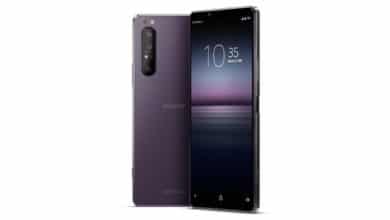
Just like last year, Apple unveiled three smartphones for the current and coming year at the presentation of its new iPhone models. The biggest differences to the previous generation are the new triple camera with an additional ultra-wide angle lens, the new A13 Bionic Chip and other case colors. The previous entry-level model iPhone XR will be replaced by the Apple iPhone 11, and the iPhone XS and XS Max will be replaced by the iPhone 11 Pro and iPhone 11 Pro Max.
Further large differences in the display
The biggest difference between the individual models is still the display. Apple’s iPhone 11 only uses a 6.1-inch IPS panel without HDR with 1,792 x 828 pixels resolution (324 ppi), the iPhone 11 Pro offers an OLED display with a diagonal of 5.8 inches at 2,436 x 1,125 pixels resolution (463 ppi) and HDR. The top model iPhone 11 Pro Max uses a 6.5-inch OLED display with 2,688 x 1,242 pixels resolution (456 ppi), which of course also offers HDR.

The display built into the iPhone 11 Pro and 11 Pro Max is named “Super Retina XDR” and offers 2,000,000:1, twice the contrast of the previous generation. The maximum brightness is 1,200 cd/m² as with the Samsung Galaxy Note 10+. The typical brightness of 800 cd/m² instead of 625 cd/m² has also increased slightly. Unfortunately Apple has replaced the previous “3D Touch” with the new “Haptic Touch” and thus deactivated the previous intensity detection of the touches. Instead, all new iPhone models only react with a noticeable feedback after a long press on the display.

iPhone 11 Pro and 11 Pro Max with Triple Camera
Both the new iPhone 11 Pro and the 11 Pro Max now have a triple camera on the back. The main camera with 12 megapixel resolution (aperture f/1.8) is complemented by a zoom camera (aperture f/2.0) and an ultra wide angle camera (aperture f/2.4) which also have 12 megapixel resolution. The iPhone 11 without Pro addition must however do without the additional ultra wide angle lens. The front camera is identical on all models and has 12 megapixels (aperture f/2.2) and a display flash.
An update for iOS 13 coming in autumn introduces the so-called “Deep-Fusion-Photography“, which temporarily stores eight photos and automatically creates a combination from the photos, which can then be used as a final photo. The Bionic 13 chip has a new “Neural Engine” that can select which of the images offers the best image quality.
Users who regularly record videos with their iPhones will be pleased that the extended dynamic range can now also be used via the front camera. In addition, 60 FPS instead of 30 FPS at 4K resolution are now possible via the main camera. The front camera is still limited to 30 FPS.
New Bionic 13 processor offers more performance and lower power consumption
The new Bionic 13 processor is manufactured using the 7 nm process and therefore requires significantly less energy than its predecessor, which results in longer battery life. According to Apple, the performance of the two performance cores is 20 percent higher than that of the Bionic 12 processor with 30 percent less power consumption. The four efficiency cores save 40 percent power and offer 20 percent more computing power and the integrated GPU is also 20 percent faster and 40 percent more economical. Apple has also increased Neural Engine performance by 20 percent with 15 percent less power consumption.

Apple has not released the memory size for any of the new iPhone models.
Battery life up to five hours higher
Thanks to the more efficient processor, Apple has succeeded in increasing the battery life of the batteries, whose capacity the company has not yet released, by four hours on the iPhone 11 Pro and by five hours on the 11 Pro Max. The iPhone 11 Pro can play up to 18 hours of offline video or stream up to 11 hours of video or 65 hours of music over the Internet. The iPhone 11 Pro Max even has 20 hours of offline video use or 12 hours or 80 hours of streaming. The battery life of the iPhone 11 is one hour longer than that of the iPhone XR.
In addition, the batteries can now be charged with 18 Watt instead of 5 Watt charging by cable. Alternatively, wireless charging via Qi standard is still possible.
Housing with IP68 certification in new colours
The two Pro models of the iPhone 11 feature a stainless steel case with a matt glass back. The colours available are Gold, Space Gray, Silver and Midnight Green. Thanks to IP68 certification, which extends Apple’s water depth from 2 meters to 4 meters, iPhones can remain underwater for a maximum of 30 minutes.
The iPhone 11 without Pro add-on is also IP68 certified, but only supports water depths of up to two meters. The colours available are Black, Green, Yellow, Purple, Red and White.
Start of sales end of September
Apple is accepting pre-orders for the new iPhone models from 13 September. Shipping and sales in the Apple Shops will start in Germany on September 20.
The iPhone 11 is available with 64 GB for 799 Euro, 128 GB for 849 Euro and 256 GB for 969 Euro. With the iPhone 11 Pro Apple requires 1.149 euro for 64 GB, 256 GB cost 1.319 euro and 512 GB strike with 1.549 euro to book. Even more expensive it becomes with the iPhone 11 pro Max with 64 GB 1,249 euro costs, 256 GB cost 1,419 euro and 512 GB cost 1,649 euro costs.
Unfortunately none of the new iPhone models are offered with 5G, which could become a disadvantage in the future especially due to the typically long useful life of iPhones. At least LTE Advanced Pro offers up to 1,000 Mbit/s download and 150 Mbit/s upload in all models.






